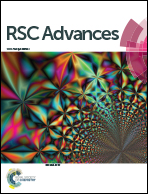Exploring the in vivo fates of RGD and PEG modified PEI/DNA nanoparticles by optical imaging and optoacoustic imaging†
Abstract
To explore the novel nanoparticles with the abilities of long-term circulation and tumor targeting, poly(ethylene glycol) modified polyethylenimine (PEI) with and without RGD peptide ligands were synthesized, which were denoted as PEI–PEG and PEI–PEG–RGD respectively. Gene transfection efficiency and intracellular uptake of the nanoparticles were evaluated in RGD binding receptors expressing human cervical cancer cells (HeLa cells). Mouse breast cancer cells (EMT-6 cells), lacking RGD binding receptors, were used as the negative control. The in vitro results showed that the RGD targeting group exhibited much more strongly increased cellular uptake in HeLa cells compared with EMT-6 cells. The PEI/DNA-Cy5, PEI–PEG/DNA-Cy5 and PEI–PEG–RGD/DNA-Cy5 nanoparticles were administrated into the nude mice bearing xenograft tumor model via intravenous injection. The traditional optical imaging and multispectral optoacoustic imaging were used to investigate the in vivo behaviors of the DNA loaded nanoparticles. The results showed that the targeting nanoparticles exhibited preferential and persistent accumulation in tumors compared to the non-targeting groups.


 Please wait while we load your content...
Please wait while we load your content...